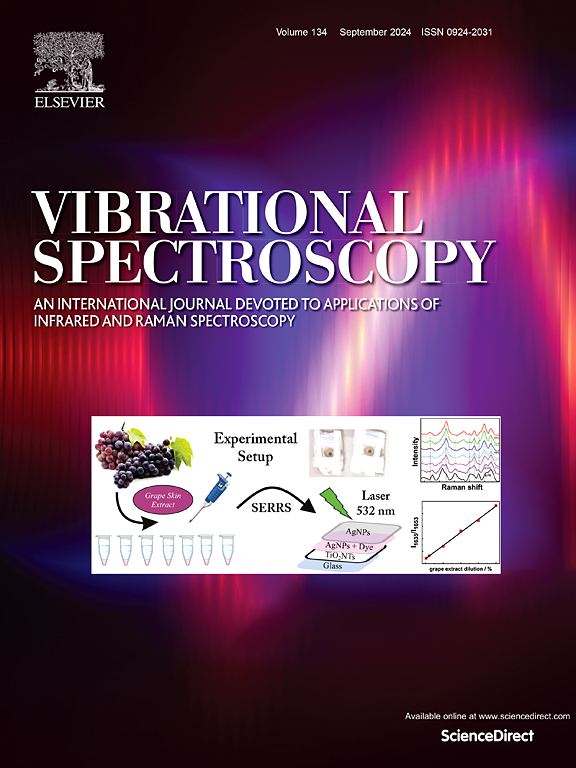利用拉曼光谱结合化学计量学对指甲油中动物脂肪掺假进行鉴定分析
IF 3.1
3区 化学
Q2 CHEMISTRY, ANALYTICAL
引用次数: 0
摘要
许多人每天都在使用化妆品,而且化妆品的消费量每年都在上升。这些产品掺入了更便宜的替代品以增加利润。随着市场上越来越多的化妆品,清真化妆品的真实性引起了全世界穆斯林消费者的极大关注。因此,迫切需要对化妆品进行认证分析。本研究采用拉曼光谱法结合化学计量学检测指甲油中的牛油(BT)、鸡脂(CF)、猪油(LD)和羊肉脂肪(MF)。偏最小二乘判别分析(PLS-DA)和层次聚类分析(HCA)成功地将动物脂肪分为四个亚类。此外,偏最小二乘(PLS)和正交PLS (ops)回归足以检测和预测指甲油中BT、CF、LD和MF的水平,校准和验证模型的R2>; 0.990。在100 ~ 3200 cm−1波数范围内,ops预测BT的最佳模型为R2>; 0.990,RMSEC和RMSEP均小于2.0 %。PLS模型预测CF、LD和MF的最佳模型为R2>; 0.990,RMSEC和RMSEP均在1-2.40 %左右。本研究揭示了拉曼光谱与化学计量学相结合作为一种有效和高效的鉴定掺假动物脂肪指甲油底料配方的潜在应用前景。本文章由计算机程序翻译,如有差异,请以英文原文为准。
Authentication analysis of animal fats adulteration in nail polish simulation using Raman spectroscopy coupled with chemometrics
Cosmetics are being used daily by many people, and their consumption is on the rise every year. These products are adulterated with cheaper alternatives to increase their profit. As more cosmetics are available in the market, the authenticity of halal cosmetics has raised much concern among Muslim consumers throughout the world. Therefore, authentication analysis of cosmetic products is urgently needed. This study was conducted to detect beef tallow (BT), chicken fat (CF), lard (LD), and mutton fat (MF) in nail polish using Raman spectrometry combined with chemometrics. Partial least square-discriminant analysis (PLS-DA) and hierarchical cluster analysis (HCA) were successfully used to differentiate animal fats into four subclasses. In addition, partial least square (PLS) and orthogonal PLS (OPLS) regression were adequate to detect and predict the levels of BT, CF, LD, and MF in nail polish with R2> 0.990 both in calibration and validation models. The best prediction model for BT was from OPLS at the wavenumber range of 100–3200 cm−1 with R2> 0.990 and RMSEC as well as RMSEP lower than 2.0 %. Meanwhile PLS model demonstrated the best model to predict CF, LD, and MF was the PLS with R2> 0.990 and RMSEC as well as RMSEP around 1–2.40 %. This study revealed the potential application of Raman spectroscopy in combination with chemometrics as an effective and efficient technique for authenticating nail polish base formulation adulterated with animal fats.
求助全文
通过发布文献求助,成功后即可免费获取论文全文。
去求助
来源期刊

Vibrational Spectroscopy
化学-分析化学
CiteScore
4.70
自引率
4.00%
发文量
103
审稿时长
52 days
期刊介绍:
Vibrational Spectroscopy provides a vehicle for the publication of original research that focuses on vibrational spectroscopy. This covers infrared, near-infrared and Raman spectroscopies and publishes papers dealing with developments in applications, theory, techniques and instrumentation.
The topics covered by the journal include:
Sampling techniques,
Vibrational spectroscopy coupled with separation techniques,
Instrumentation (Fourier transform, conventional and laser based),
Data manipulation,
Spectra-structure correlation and group frequencies.
The application areas covered include:
Analytical chemistry,
Bio-organic and bio-inorganic chemistry,
Organic chemistry,
Inorganic chemistry,
Catalysis,
Environmental science,
Industrial chemistry,
Materials science,
Physical chemistry,
Polymer science,
Process control,
Specialized problem solving.
 求助内容:
求助内容: 应助结果提醒方式:
应助结果提醒方式:


